Introduction
AI is no longer optional in the telecom industry, it is now the cornerstone of next-generation connectivity. As network complexity and customer expectations soar, AI empowers telecom operators to optimize performance, minimize operational costs, and deliver hyper-personalized services at scale. By exploring actionable AI use cases in telecom, from predictive maintenance to intelligent customer engagement, this article reveals how AI technologies are unlocking new revenue streams and shaping the future of connectivity.
What is AI and Why Does It Matter in Telecom?
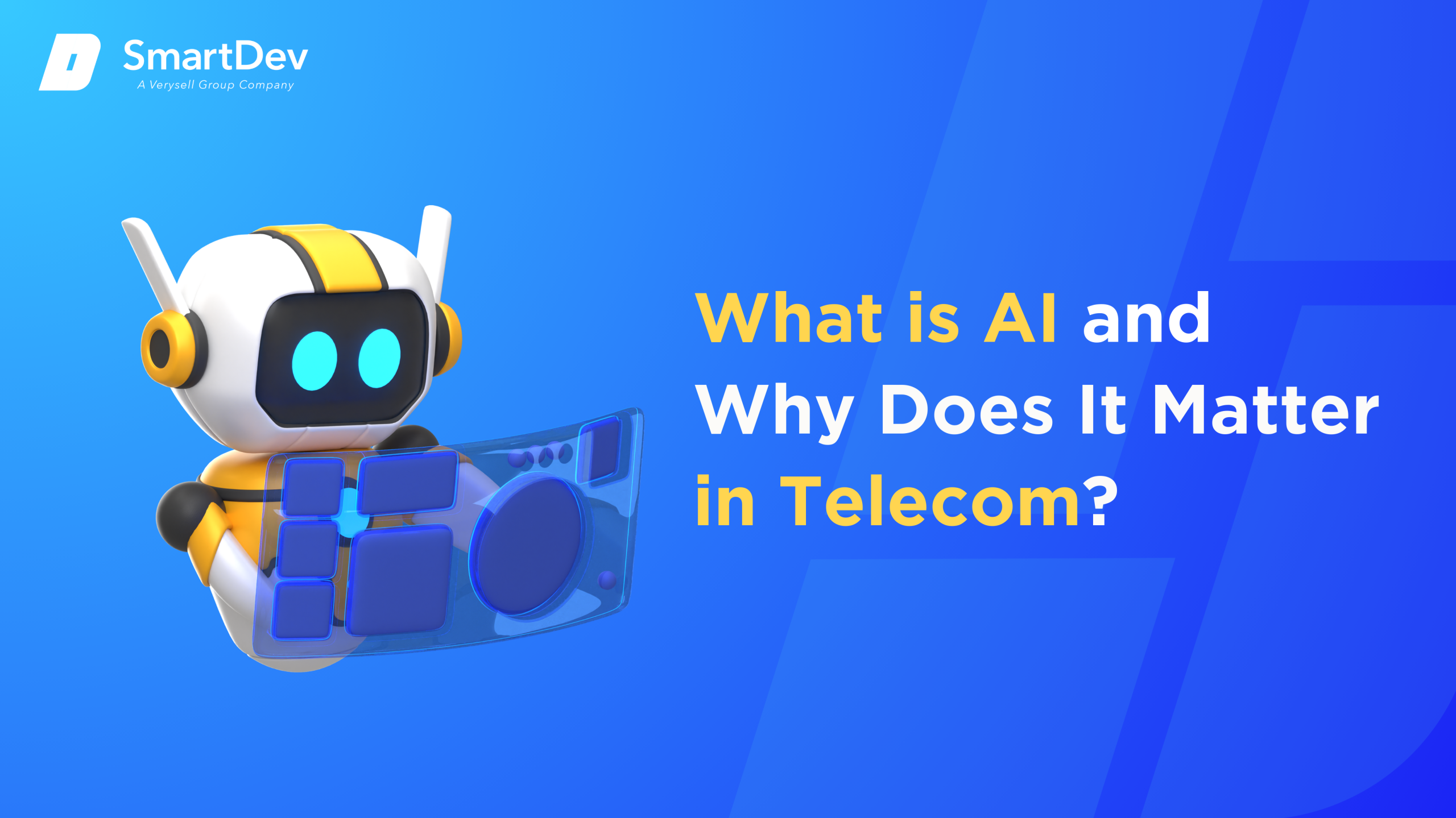
Definition of AI and its core technologies
Artificial Intelligence (AI) refers to the simulation of human intelligence in machines that are programmed to mimic human cognitive abilities, enabling machines to analyze data, recognize patterns, and make informed decisions. At its core, AI encompasses Machine Learning (ML), which allows systems to improve with experience; Natural Language Processing (NLP), which enables computers to understand and generate human language; and Computer Vision, which interprets visual data to enhance automation and analytics.
As networks expand and data volumes surge, telecom operators face growing pressure to deliver faster, more reliable, and personalized services. AI-powered solutions help meet these demands by automating operations, predicting issues before they arise, and enabling smarter, data-driven decisions. This shift allows telecom providers to optimize performance, reduce costs, and elevate the customer experience at scale.
The Growing Role of AI in Transforming Telecom
AI’s role in telecom is expanding rapidly as networks become more complex and customer expectations grow. From automating manual tasks to predicting network demands, AI enables operators to move beyond reactive management. Real-time insights and intelligent automation are now critical to maintaining seamless connectivity and operational efficiency.
Beyond the network, AI is reshaping how telecom providers engage with customers. Intelligent systems personalize offers, power virtual assistants, and predict churn with remarkable accuracy. As competition intensifies, AI-driven customer experiences are becoming essential for boosting satisfaction, loyalty, and long-term revenue.
Key Statistics and Trends Highlighting AI Adoption in Telecom
- Explosive Market Growth: AI in telecom is projected to surge, with the global market expected to reach between $19.4 billion and $58.7 billion by 2032, reflecting annual growth rates exceeding 40% CAGR.
- Widespread Adoption: AI technologies are becoming integral to telecom operations, with many leading operators already implementing solutions across key areas.
- Generative AI on the Rise: Generative AI is rapidly gaining traction in telecom as providers explore its potential to enhance service delivery, streamline operations, and unlock new revenue opportunities with AI-powered solutions.
- Proven Operational Impact: Over 75% of telecom operators report that AI has reduced operational costs, while 84% say it has boosted annual revenues.
- Customer Experience Transformation: AI is enabling proactive issue resolution, hyper-personalization, and 24/7 service through intelligent chatbots and virtual assistants.
Business Benefits of AI in Telecom
AI is driving transformative value across the telecom industry. From operational excellence to customer-centric innovations, AI-powered solutions are helping operators unlock new levels of efficiency, agility, and profitability.
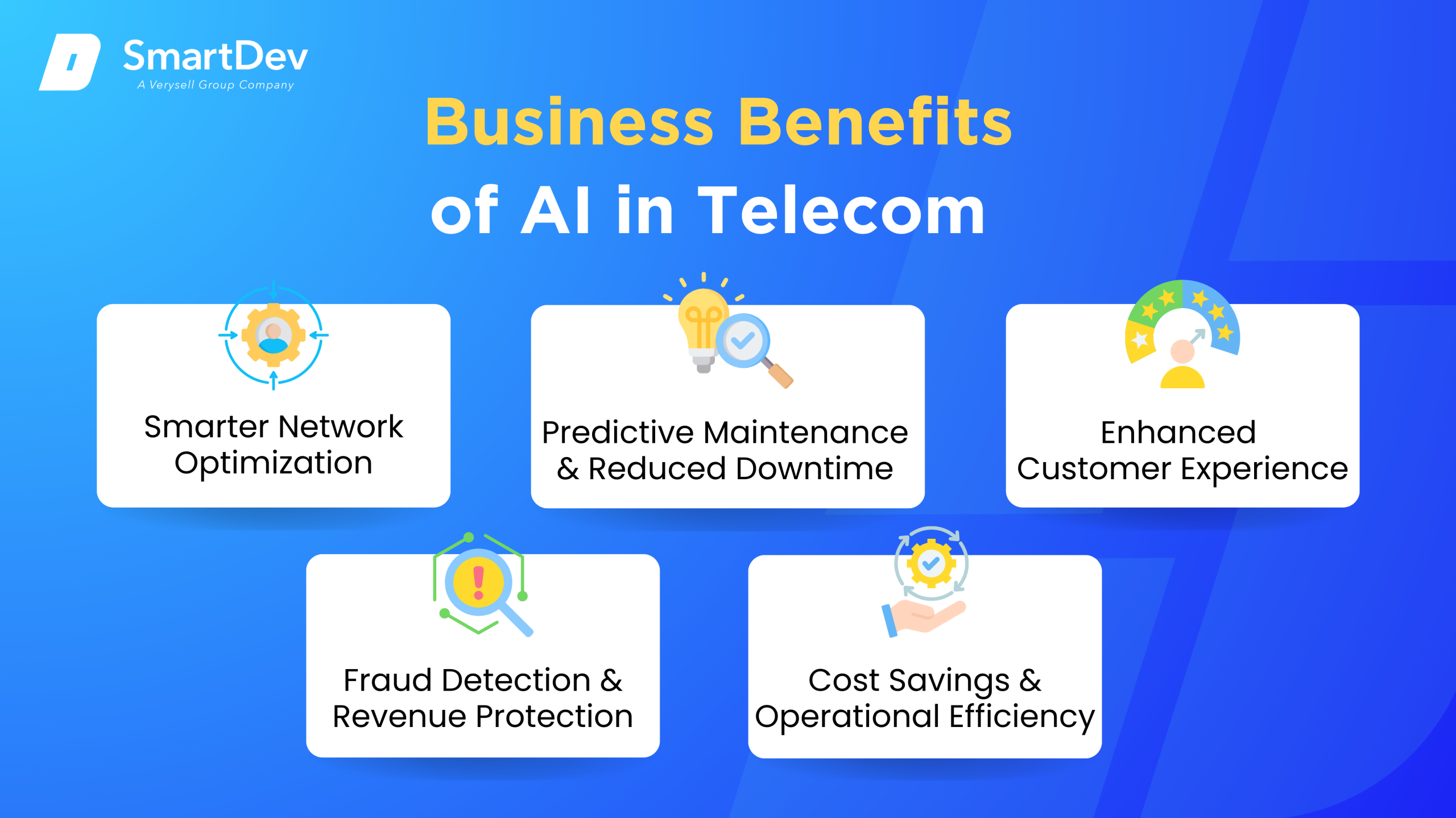
1. Smarter Network Optimization
AI is transforming how telecom operators manage complex and data-heavy networks. By continuously analyzing real-time traffic patterns, AI predicts congestion and automatically reroutes data to maintain optimal performance. This intelligent network management reduces downtime, ensures seamless connectivity, and enhances the overall user experience.
2. Predictive Maintenance and Reduced Downtime
Unexpected outages can disrupt service and impact customer satisfaction. AI helps telecom providers avoid these risks by identifying anomalies and forecasting potential equipment failures before they happen. This proactive approach minimizes downtime, lowers maintenance costs, and ensures uninterrupted service delivery.
3. Enhanced Customer Experience
AI is elevating customer service by enabling more personalized, timely, and responsive interactions. Through virtual assistants, intelligent chatbots, and advanced analytics, telecom providers can anticipate customer needs and offer tailored support instantly. This drives higher satisfaction, improves retention, and fosters long-term loyalty in an increasingly competitive market.
4. Fraud Detection and Revenue Protection
Fraud continues to pose serious risks to telecom revenues and customer trust. AI strengthens defense mechanisms by analyzing patterns in real time and detecting suspicious activities before they escalate. This real-time fraud prevention safeguards revenue streams, protects sensitive data, and reinforces brand credibility.
5. Cost Savings and Operational Efficiency
AI streamlines telecom operations by automating repetitive and time-consuming tasks across key areas. From network monitoring to customer support, AI optimizes workflows and reduces the need for manual intervention. This drives significant cost savings, improves productivity, and enables providers to focus on innovation and growth.
Challenges Facing AI Adoption in Telecom
While AI presents powerful opportunities for telecom, integrating it into core operations is not without hurdles. From data complexities to organizational readiness, several challenges can slow or limit AI’s full potential. Addressing these barriers is essential to maximize the value of AI-powered solutions.
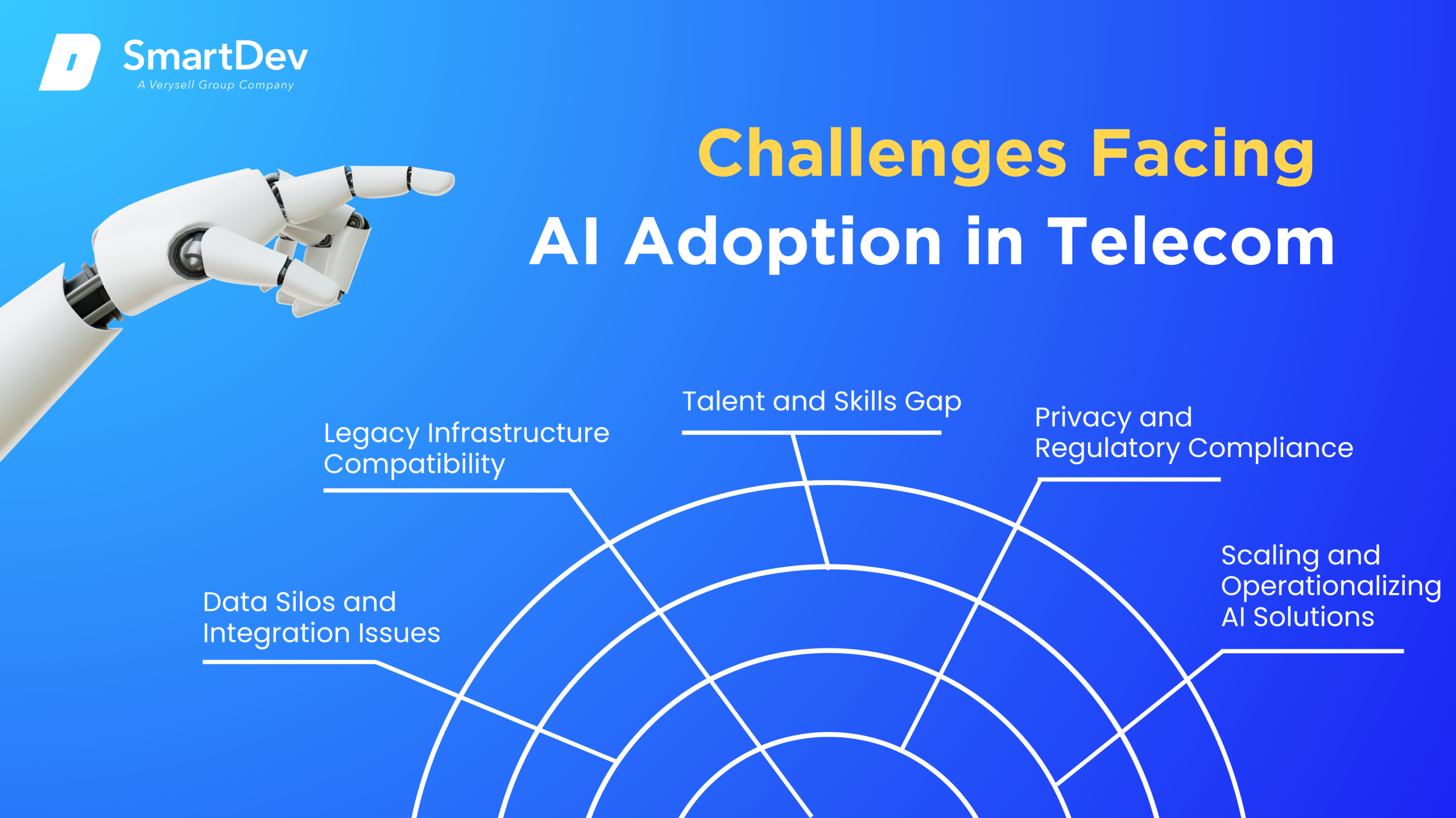
1. Data Silos and Integration Issues
AI relies on unified, high-quality data to deliver accurate insights and drive intelligent decisions. However, telecom operators often face fragmented systems and disconnected datasets that slow progress. Breaking down these silos is essential to maximize AI’s potential and enable organization-wide intelligence.
2. Legacy Infrastructure Compatibility
Many telecom networks still run on legacy systems that were never designed for AI integration. Connecting advanced AI solutions to outdated platforms can be complex and resource intensive. Without modernization or seamless integration, AI-driven initiatives may struggle to scale and deliver meaningful results.
3. Talent and Skills Gap
AI implementation requires specialized expertise, yet many telecom operators face shortages of key roles such as data scientists and AI engineers. Without skilled professionals to develop, manage, and optimize AI systems, projects risk underperformance or stagnation. Bridging this talent gap is essential for sustainable and impactful AI adoption.
4. Privacy and Regulatory Compliance
Telecom companies manage vast amounts of sensitive customer data, which makes privacy and regulatory compliance non-negotiable. Integrating AI raises complex challenges related to data ethics, security, and transparency. Navigating these requirements carefully is crucial to avoid penalties and maintain customer trust.
5. Scaling and Operationalizing AI Solutions
While pilot AI projects often show promise, expanding them across enterprise-wide telecom operations is challenging. Issues around deployment, governance, and change management can stall momentum and limit returns. To realize AI’s full value, operators need clear strategies for scaling initiatives effectively and embedding them into daily workflows.
Specific Applications of AI in Telecom
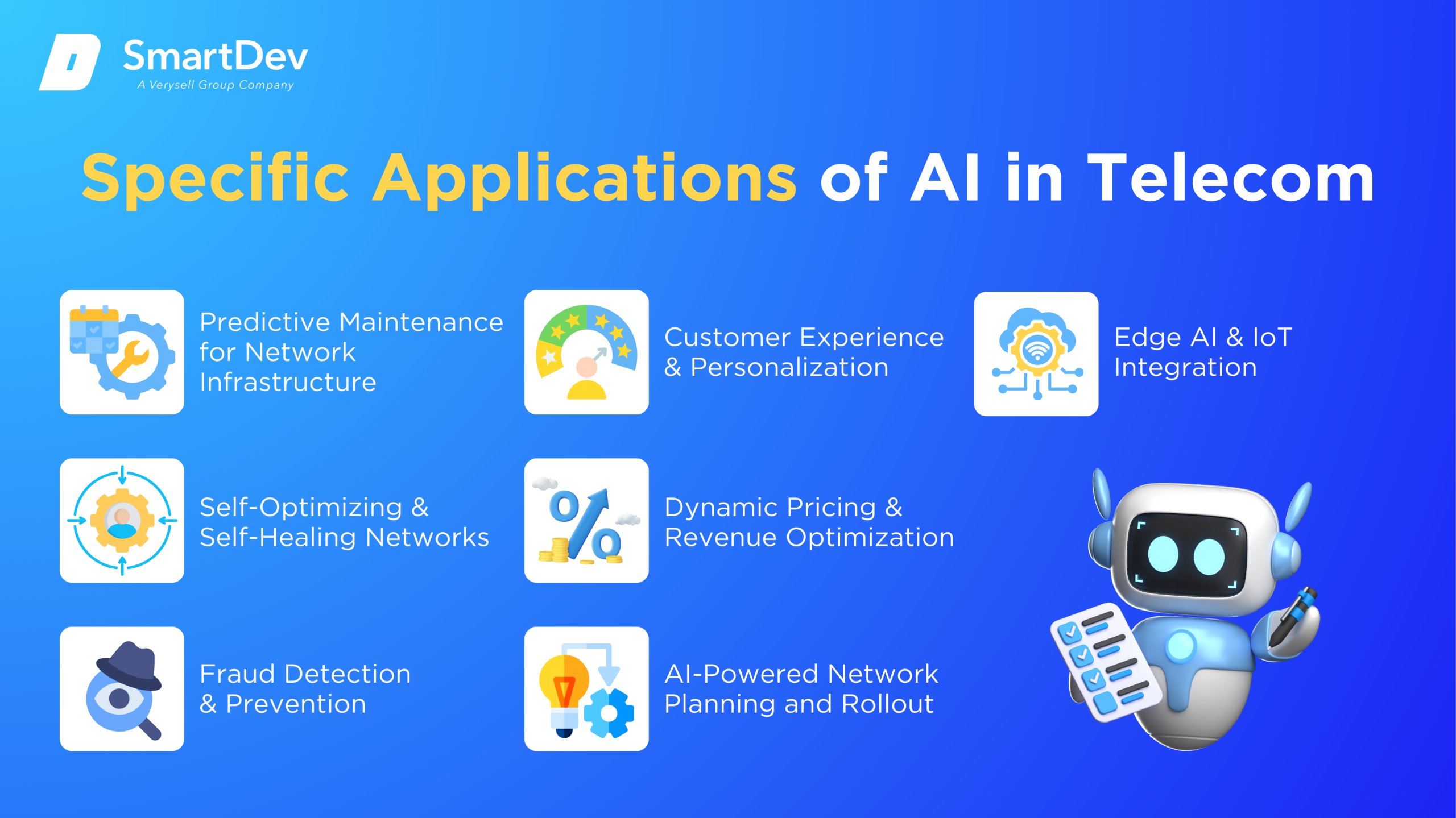
1. Predictive Maintenance for Network Infrastructure
Unplanned equipment failures are a significant cause of service disruptions in the telecom industry, leading to increased costs and customer dissatisfaction. Traditional methods, such as time-based maintenance, often either over-service infrastructure or fail to catch critical issues in time, causing unnecessary downtime.
AI-based predictive maintenance solves this challenge by analyzing real-time sensor data and historical network performance trends. Using machine learning algorithms, telecom providers can detect anomalies in temperature, voltage, and usage patterns, predicting failures before they happen. This proactive approach allows for timely repairs, minimizing downtime and extending the lifespan of network assets.
Real-World Case Study: Vodafone
Vodafone leverages AI-driven predictive analytics, powered by Google Cloud, to monitor more than 150,000 network elements across Europe. The AI system proactively identifies equipment risks, resulting in a 30% reduction in network outages.
By automating fault prediction, Vodafone has significantly reduced unnecessary maintenance, optimizing operational efficiency and ensuring a more reliable network for customers.
2. Self-Optimizing and Self-Healing Networks
Telecom networks are constantly under pressure due to fluctuating traffic patterns, signal interference, and user mobility. Manual network configurations can’t keep up with these real-time changes, often resulting in network congestion, service degradation, and increased downtime.
AI-driven self-optimizing networks allow telecoms to automatically adjust parameters like signal strength, bandwidth, and handovers. AI also powers self-healing networks, which autonomously identify and resolve faults, maintaining seamless connectivity and consistent performance without human intervention.
Real-World Case Study: AT&T
AT&T uses AI-powered ONAP (Open Network Automation Platform) to manage network optimization and fault resolution autonomously. This AI platform adjusts configurations in real-time to maintain service quality.
As a result, AT&T has reduced downtime, improved data throughput, and reduced the operational burden on human network engineers. This has made AI a core pillar of AT&T’s intelligent infrastructure strategy.
3. Fraud Detection and Prevention
Telecom fraud, including SIM swapping, fake roaming, and subscription fraud, is a growing concern that costs the industry billions. Traditional fraud detection systems based on static rules are often slow and prone to false positives, leading to inefficiencies in fraud prevention.
AI enhances fraud detection by continuously analyzing user behavior, transaction data, and network activity. Machine learning models can detect anomalous patterns in real-time, adapt to new fraud tactics, and trigger instant responses to mitigate risk.
Real-World Case Study: Telefónica
Telefónica uses LUCA AI, its data and AI platform, to apply hybrid machine learning models to analyze real-time telecom transactions. The system detects fraudulent activity with over 90% accuracy, preventing major revenue losses.
This proactive approach reduces false positives and ensures real-time intervention, safeguarding both telecom companies’ margins and customers’ trust.
4. Customer Experience and Personalization
As customer expectations rise, telecom operators need to deliver faster, more personalized experiences to stay competitive. Generic service offerings, long wait times, and impersonal customer support can lead to churn and lost revenue.
AI enables telecom providers to offer hyper-personalized experiences by leveraging Natural Language Processing (NLP)-powered chatbots and recommendation engines. These AI systems handle customer inquiries 24/7, suggest relevant plans, and offer content based on usage behavior, preferences, and sentiment analysis.
Real-World Case Study: Reliance Jio
Reliance Jio’s AI assistant, Jio Saarthi, built with Haptik and Azure AI, automates more than 10 million daily customer interactions. It personalizes offers based on real-time analysis of customer behavior and sentiment.
By combining AI-powered self-service and behavioral insights, Jio reduced customer service costs while improving user retention in a competitive market.
5. Dynamic Pricing and Revenue Optimization
Traditional pricing structures in telecom often fail to reflect real-time network conditions, individual customer value, or market demand, leading to missed revenue opportunities and inefficient resource usage.
AI enables telecom companies to implement dynamic pricing strategies that adjust in real-time based on user behavior, network load, and market conditions. By analyzing these variables, AI models optimize pricing, recommend upsell opportunities, and improve promotional timing, ensuring higher Average Revenue Per User (ARPU) and better customer satisfaction.
Real-World Case Study: Swisscom
Swisscom uses SAS Viya’s AI platform to fine-tune pricing dynamically. The AI engine evaluates user data and external market conditions to deliver personalized offers at the optimal time.
This approach has led to a boost in ARPU, as Swisscom is now able to better match pricing with individual customer needs and behaviors.
6. AI-Powered Network Planning and Rollout
Expanding telecom infrastructure, especially with 5G and fiber networks, requires precise planning to avoid overbuilding or underutilizing network resources. Without data-driven planning, operators risk misallocating capital and delaying returns on investment.
AI supports telecom companies by prioritizing rollout areas using demographic data, usage heatmaps, and demand forecasts. These AI models simulate potential ROI and optimize network expansion strategies, ensuring the most impactful infrastructure deployment.
Real-World Case Study: Telenor
Telenor uses AI models developed with Accenture and AWS SageMaker to streamline its 5G rollout. Geospatial analysis helps identify high-impact areas for investment.
With AI, Telenor reduced its network rollout planning time by 50% and optimized tower placements, ensuring maximum coverage efficiency and return on investment.
7. Edge AI and IoT Integration
With the growth of IoT and real-time services, centralized cloud processing can no longer meet the speed and reliability demands of latency-sensitive applications. Moving processing closer to the source, at the edge, is essential for supporting real-time decision-making.
Edge AI enables data processing at the network’s edge, reducing latency and enhancing the responsiveness of smart city infrastructure, connected vehicles, and industrial IoT. This also ensures greater data privacy by keeping sensitive data local.
Real-World Case Study: Verizon
Verizon integrates AWS Greengrass and Panorama to deploy AI at the edge, powering smart traffic management and industrial IoT applications.
This edge-first strategy reduces latency, ensures reliable local analytics, and provides high-quality service for enterprise clients while opening new business opportunities in advanced AI capabilities.
Looking forward, AI’s role in intelligent network management will only deepen. As networks become increasingly software-defined, AI will enable real-time reconfiguration based on shifting demand and usage. This will allow telecom operators to maintain cost efficiency while delivering seamless, high-quality connectivity in a rapidly evolving digital landscape.
Examples of AI in Telecom
Real-World Case Studies

1. Verizon: Generative AI for Customer Loyalty and Retention
Verizon leverages generative AI to transform customer service and reduce churn. Its AI solution predicts reasons behind 80% of its 170 million annual customer calls, proactively addressing concerns before they lead to dissatisfaction. This initiative is projected to prevent over 100,000 potential customer losses annually, significantly enhancing retention and improving customer lifetime value.
By integrating AI into its support system, Verizon not only reduces churn but also boosts customer satisfaction through faster issue resolution. This predictive approach strengthens customer relationships and helps Verizon maintain its competitive position in a saturated market.
2. Rakuten Mobile: Intelligent Network Planning and Cost Optimization
Rakuten Mobile employs AI-powered network planning to streamline its 5G rollout and optimize capital investment. By analyzing real-time user behavior, geographic data, and demand forecasts, Rakuten cut deployment costs by 40%. This allowed the company to accelerate its market entry while ensuring robust network quality.
AI-driven planning not only reduced expenses but also enhanced user experience by guaranteeing optimal coverage. This smart deployment strategy positioned Rakuten as an agile competitor in the fast-evolving telecom landscape.
3. Vodafone: AI Chatbots for Customer Support Efficiency
Vodafone’s AI chatbot, TOBi, has transformed how the company manages customer inquiries. TOBi now handles over 70% of customer interactions without human involvement, resolving billing, plan management, and support queries instantly.
This automation has significantly reduced operational costs while improving user satisfaction through quicker response times. By freeing human agents to handle complex issues, Vodafone ensures better resource allocation and higher-quality support.
Innovative AI Solutions
AI is rapidly advancing, introducing innovative solutions that are transforming how telecom operators manage and optimize their businesses. These capabilities are not just enhancing telecom processes, they are fundamentally reshaping how providers deliver services, drive efficiency, and stay competitive in a rapidly evolving industry.
- Predictive Maintenance for Proactive Network Management: AI models analyze sensor data, network logs, and usage patterns to forecast equipment issues before they occur. This allows operators to schedule maintenance in advance, reducing unexpected outages, minimizing repair costs, and ensuring seamless service continuity.
- Dynamic Pricing and Hyper-Personalized Offers: AI enables real-time price adjustments based on demand, network load, and customer behavior. Operators can offer dynamic plans and personalized bundles, increasing ARPU (Average Revenue Per User) while fostering stronger customer loyalty and reducing churn.
- AI-Powered Fraud Detection and Revenue Assurance: AI detects fraud in real time by analyzing massive datasets for irregular patterns such as SIM box fraud or IRSF. Alongside fraud prevention, AI also ensures billing accuracy, reducing revenue leakage and maintaining customer trust.
- Generative AI and Conversational AI for Customer Engagement: Emerging generative AI models power advanced virtual assistants and chatbots that deliver personalized, natural conversations. These solutions enable 24/7 support, multilingual interactions, and predictive responses that improve customer satisfaction and operational efficiency.
- AI-Enhanced Network Planning and Deployment Automation: AI analyzes geographical, demographic, and usage data to optimize where and when new infrastructure should be deployed. This reduces deployment costs and accelerates network rollouts, helping operators meet demand faster while maintaining service quality.
AI-Driven Innovations Transforming Telecom
Emerging Technologies in AI for Telecom
- Generative AI Applications: Generative AI is reshaping telecom by automating content and knowledge creation. From generating customer support responses and network configuration documents to drafting marketing and service communications, AI helps operators scale content production effortlessly. Solutions like large language models streamline routine tasks, enhance personalization, and accelerate response times, improving both internal efficiency and customer experiences.
- Computer Vision for Visual Data Analysis: Computer vision is enabling telecom operators to monitor infrastructure visually with unprecedented precision. By analyzing video feeds and drone-captured images, AI can detect faults in towers, cables, and other assets before they cause disruptions. This reduces the need for manual inspections, speeds up maintenance workflows, and ensures more reliable network performance.
AI’s Role in Sustainability Efforts
- Reducing Waste Through Predictive Analytics: AI-powered predictive analytics helps telecom providers forecast network usage patterns and allocate resources accordingly. By aligning network capacity with actual demand, operators minimize unnecessary energy usage and avoid overbuilding infrastructure. This leads to significant reductions in waste and supports more responsible resource management.
- Optimizing Energy Consumption with Smart Systems: AI-driven smart systems automatically optimize power usage across network operations. These solutions can adjust energy consumption based on traffic loads, switch to renewable energy when available, and manage equipment more efficiently. This intelligent automation cuts costs and reduces carbon emissions without compromising service quality.
- Supporting Greener Telecom Operations: By integrating AI into their sustainability strategies, telecom operators demonstrate leadership in environmental responsibility. AI-driven energy optimization and waste reduction initiatives strengthen eco-friendly branding while meeting growing customer and regulatory demands for greener connectivity solutions.
How to Implement AI in Telecom
Successfully integrating AI into telecom operations requires a strategic and phased approach. From identifying the right opportunities to ensuring team readiness, each step plays a vital role in maximizing the value of AI investments. Here’s a roadmap to guide telecom operators through the implementation journey.
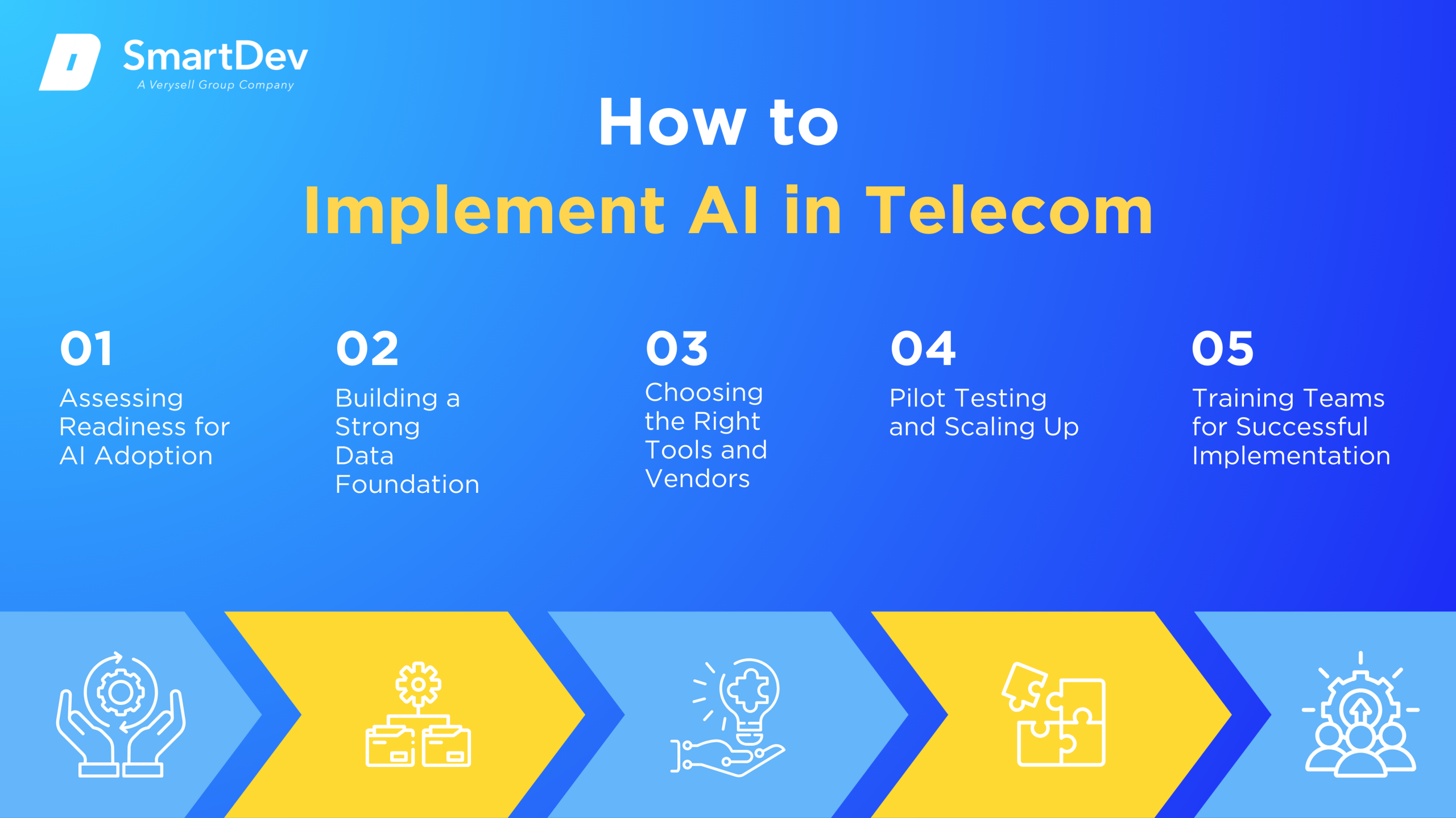
Step 1. Assessing Readiness for AI Adoption
The first step is to evaluate where AI can deliver the most impact. Telecom providers should identify key business areas that will benefit from AI integration, such as network optimization, customer support, fraud detection, or churn prediction. Prioritizing use cases based on potential ROI, operational challenges, and business goals ensures a focused and effective AI strategy.
Step 2. Building a Strong Data Foundation
AI’s effectiveness depends on the quality of its data. Collecting, cleaning, and managing data properly ensures models produce accurate and actionable insights. Telecom operators should break down data silos and establish clear governance to create a reliable foundation for AI success.
Step 3. Choosing the Right Tools and Vendors
Not all AI solutions are created equal, so selecting the right platforms is essential. Look for tools designed specifically for telecom, offering real-time analytics, automation, and scalability. Partnering with trusted vendors ensures seamless integration and access to domain expertise.
Step 4. Pilot Testing and Scaling Up
Starting small allows telecom operators to test AI’s impact before full deployment. Pilot programs help fine-tune models, uncover challenges, and demonstrate value. Once proven, scaling up across broader operations becomes smoother and more strategic.
Step 5. Training Teams for Successful Implementation
AI works best when combined with skilled human oversight. Upskilling employees ensures they can effectively interpret AI-driven insights and make informed decisions. Investing in training fosters adoption and prepares teams to work confidently alongside intelligent technologies.
Measuring the ROI of AI in Telecom
AI offers telecom operators the promise of smarter operations, optimized costs, and enhanced customer experiences, but how can you be sure it’s delivering results?
Measuring the return on investment (ROI) of AI requires tracking the right performance indicators, validating with real-world success stories, and avoiding common implementation mistakes.
Key Metrics to Track Success
- Productivity Improvements:AI greatly boosts operational productivity by automating repetitive tasks across network management, customer support, and fraud detection.Measuring time saved, faster issue resolution, and increased case handling capacity will show how AI enables teams to focus on more strategic and value-driven work.
- Cost Savings Achieved Through Automation: By reducing the need for manual intervention, AI directly lowers operational expenses.Automated maintenance, optimized energy usage, and fraud prevention cut costs across the board. Tracking reductions in labor hours, maintenance spend, and revenue leakage clearly demonstrates AI’s financial impact.
- Service Uptime and Reliability Gains:AI not only cuts costs but also improves service performance.Self-healing networks and predictive maintenance minimize outages, ensuring consistent uptime. Monitoring network reliability and incident reduction rates shows how AI protects revenue and enhances customer satisfaction.
- Churn Reduction and Customer Retention:AI-driven personalization and predictive analytics help reduce customer churn.Measuring retention rates, loyalty metrics, and customer lifetime value can reveal how AI impacts revenue stability by keeping users engaged and satisfied.
Case Studies Demonstrating ROI
Leading telecom operators are already realizing strong returns from AI. Verizon’s predictive maintenance models reduced network failures by 30% and cut repair costs by 25%, proving AI’s operational and financial efficiency. Similarly, Vodafone’s AI chatbot TOBi now handles 70% of customer queries autonomously, reducing support costs while improving response speed and user satisfaction.
Rakuten Mobile leveraged AI-driven network planning to cut 5G rollout costs by 40%, accelerating deployment and optimizing resource use. These examples show how AI-driven insights and automation translate into cost savings, efficiency gains, and better customer outcomes.
Common Pitfalls and How to Avoid Them
- Data Quality and Integration Issues:AI models are only as good as the data they use.Poor, fragmented, or incomplete data can lead to inaccurate insights and underperformance. Telecom operators must invest in unified data management and ensure data is clean, integrated, and accessible across platforms.
- Overestimating AI’s Short-Term Impact:AI delivers powerful benefits, but it’s not instant magic.Some operators expect rapid transformation without proper planning or testing. Avoid this by starting with pilot programs, setting realistic expectations, and scaling only after proven results.
- Neglecting Employee Adoption and Skills Development:While AI automates many processes, human oversight and interpretation remain essential.Operators should focus on upskilling staff, ensuring teams understand how to use AI insights effectively, and integrating AI into daily workflows to maximize value.
Future Trends of AI in Telecom
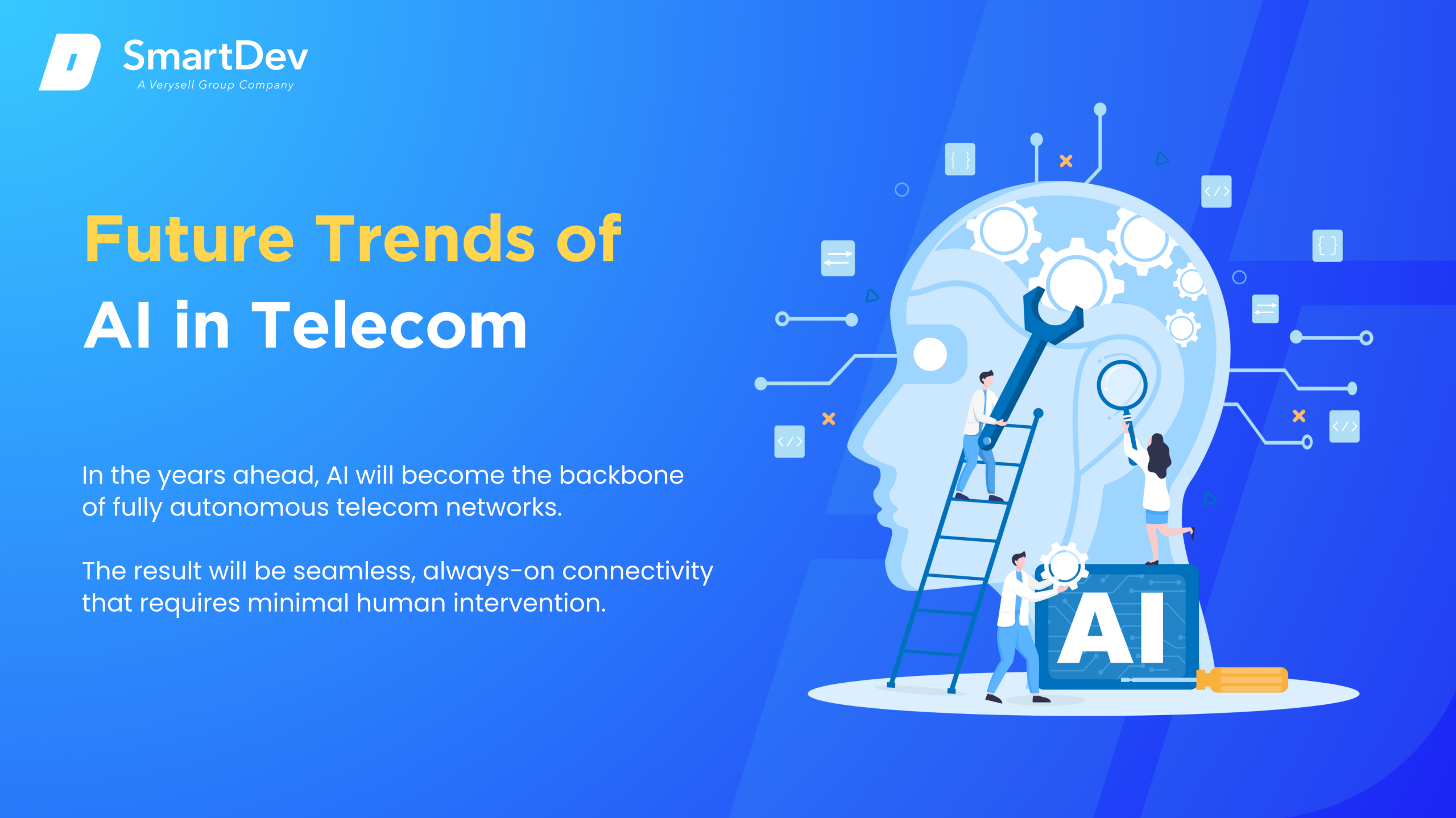
Predictions for the Next Decade
In the years ahead, AI will become the backbone of fully autonomous telecom networks. These intelligent systems will self-optimize, predict faults, and manage capacity in real time, dramatically reducing downtime and operational costs. The result will be seamless, always-on connectivity that requires minimal human intervention.
At the same time, AI will elevate personalization and sustainability efforts across the industry. Generative AI and predictive models will enable hyper-personalized plans and proactive service, strengthening customer loyalty. Meanwhile, AI-driven energy management will help operators cut carbon emissions and align network performance with global sustainability goals.
How Businesses Can Stay Ahead of the Curve
As AI transforms telecom, staying ahead will require more than adopting new technologies, it will demand a proactive and strategic mindset. Implementing the right approaches will ensure telecom providers fully leverage AI’s potential while driving long-term competitiveness.
- Invest in Scalable Data Infrastructure:Ensure data systems are capable of processing diverse, real-time network and customer data to fuel AI models and support intelligent, automated decision-making.
- Prioritize Ethical and Transparent AI:Implement responsible AI frameworks to maintain fairness, data privacy, and trust across all customer and operational interactions.
- Upskill Teams Continuously:Empower employees with ongoing training to help them stay current with AI advancements and integrate AI insights into everyday workflows effectively.
- Integrate AI Across All Operations:Adopt AI holistically across network management, customer support, marketing, and sustainability initiatives to create a unified, intelligent telecom ecosystem that drives both efficiency and superior customer experiences.
Conclusion
Key Takeaways
Artificial intelligence is revolutionizing the telecom industry, enabling operators to enhance network performance, improve customer satisfaction, and optimize operational efficiency. From automating maintenance tasks to personalizing customer interactions, AI is not just a futuristic technology but a vital tool driving tangible results in telecom today.
- Network Optimization and Maintenance:AI-powered systems predict potential network issues before they occur by analyzing real-time data and historical performance, reducing downtime and ensuring smoother, more reliable service.
- Fraud Detection and Prevention:Continuous monitoring of transaction patterns and network activity enables the detection of anomalies in real time.This capability helps prevent fraud and mitigate financial losses by acting quickly to address suspicious behavior.
- Personalized Customer Experiences:Telecom providers can leverage chatbots, recommendation engines, and sentiment analysis to offer tailored plans, targeted promotions, and immediate support.This enhances customer satisfaction and fosters loyalty by addressing individual needs effectively.
- Dynamic Pricing and Revenue Optimization:By adjusting pricing based on demand, customer behavior, and market conditions, telecom companies can optimize their revenue.This strategy ensures competitive pricing while maximizing profitability in a dynamic market environment.
- Predictive Analytics for Service Expansion:Through the analysis of demographic, geographic, and usage data, demand for network services can be forecasted.This allows telecom operators to strategically invest in infrastructure and roll out services efficiently based on predicted market needs.
Moving Forward: A Path to Progress
AI is reshaping telecom, from self-optimizing networks and predictive maintenance to dynamic pricing and proactive customer support. To stay ahead, operators must embrace innovation, strengthen their data ecosystems, and empower their teams to leverage AI as a strategic driver of growth.
By embedding AI across every layer of operations, telecom businesses can achieve greater efficiency, deliver superior customer experiences, and support sustainability goals. Those who act now will lead the next era of intelligent, agile, and customer-first connectivity.
At SmartDev, we help telecom providers unlock AI’s full potential. From AI-driven automation to predictive analytics and customer engagement solutions, our team delivers tailored, industry-specific technologies that drive measurable impact.
Ready to future-proof your telecom operations with AI?
Contact us today to discover how our AI-powered solutions can help you optimize networks, prevent churn, and deliver next-generation customer experiences while staying ahead in an increasingly competitive market.
—
References:
- Global AI In Telecom Market Size, Share, Trends | market.us
- Generative AI In Telecom Market Size, Share, and Trends 2024 to 2034 | Precedence Research
- Large Generative AI Models for Telecom: The Next Big Thing? | IEEE Communications Magazine
- AI: Opportunities and Challenges – The Optimal Exploitation of (Telecom) Corporate Data | Conference on e-Business, e-Services and e-Society







